Planning on visiting Acadia National Park in Fall? This 47,000-acre stretch of land is a dream to explore any time of the year — which is why it sees around 3.5 million visitors yearly. But there are plenty of reasons why fall might just be the best time to stop by.
With leaves transforming into various shades of red, yellow, and green, Acadia National Park becomes a photographer’s dream in the fall. Crowds start to dwindle, and the air becomes crisp and cool, making it the perfect time to explore this jewel of the North Atlantic.
Whether you’re compiling the perfect New England fall road-trip itinerary or simply seeking a quiet getaway, read on to discover all that Acadia has to offer!
📌 Save this to Pinterest!

Disclaimer: Hey explorer! This post contains affiliate links which means I earn a small percentage of each purchase made through my links. I only ever recommend products I believe in and appreciate your support if you decide to use my links—thank you!
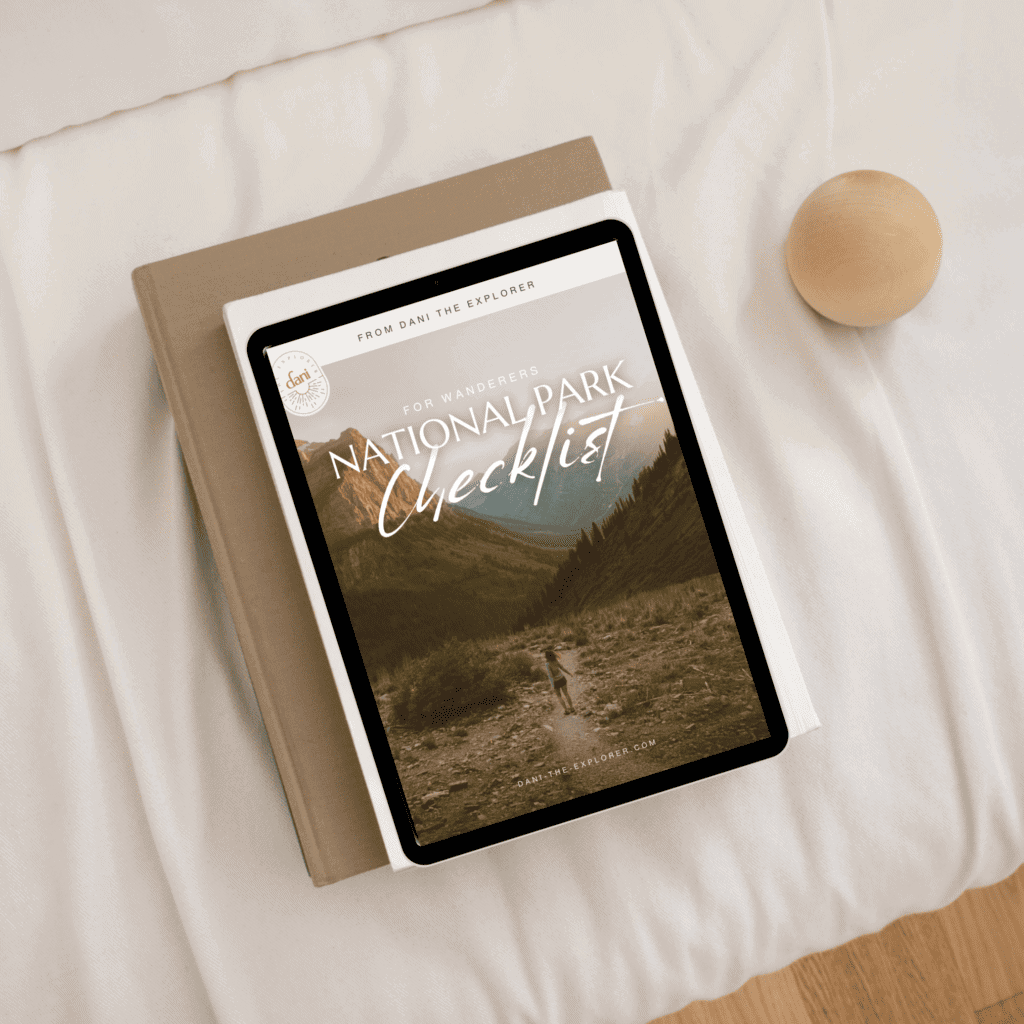
FREE US National Park Checklist
Download my printable checklist of all 63 US National Parks! You can use the digital version to explore free park guides.
Why Visit Acadia in Fall?
Why not visit Acadia National Park in the fall?
While Acadia is a top vacation spot year-round, nothing compares to the park’s spectacular transformation around October.
The warm, vibrant hues of the fall foliage contrast beautifully with the evergreen trees, blue waters, and rugged rock on the coast.
Above that, vacation-goers start to leave after school holidays, so tourist crowds and accommodation prices drop.
Temperatures also drop to daily averages around the 50s and 60s (℉).
And with dropping temperatures, comfort food like creamy lobster chowder (or lobster rolls) become necessary staples — which the nearby Bar Harbor provides in abundance.
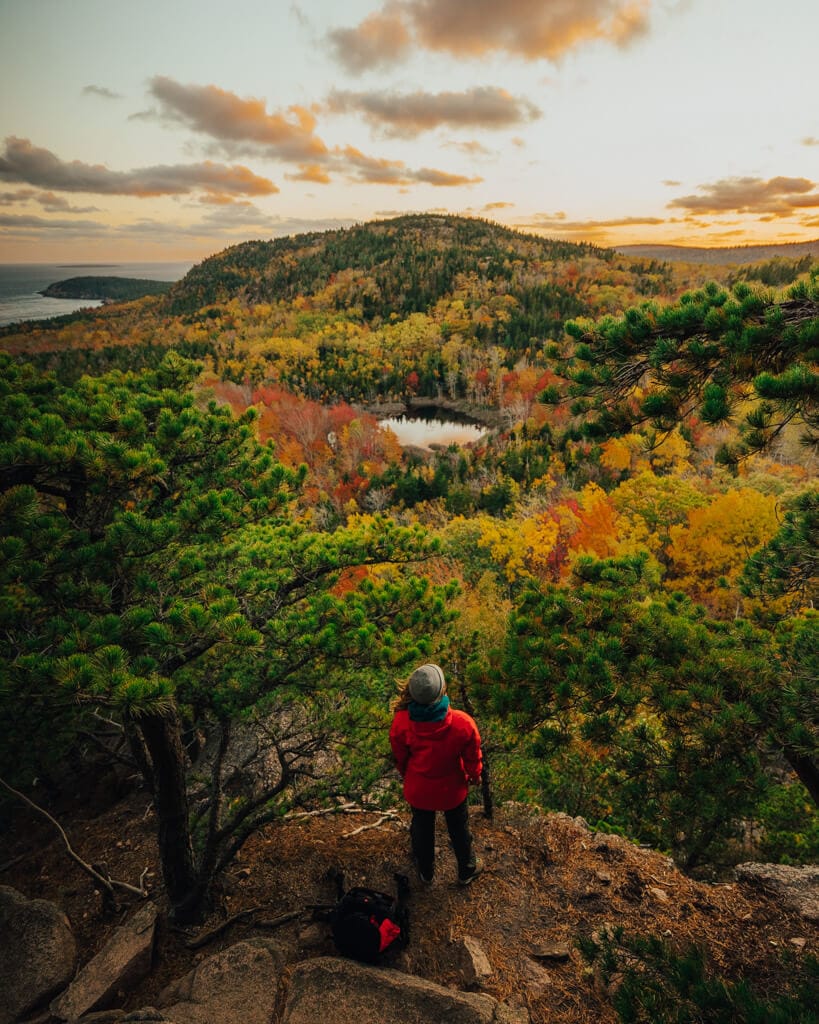
Best Time to See Acadia National Park Fall Colors
So what is the best time to see the brilliant Acadia National Park fall foliage?
The peak time to see the leaves transform into amber and golden shades is around mid-October.
This is when temperatures start to drop and the days become shorter — leading to reduced Chlorophyll production.
But, the Acadia peak foliage times can be affected by various factors, like the amount of rain and the average temperatures, meaning leaves could change earlier or later.
You can have a look at this handy fall foliage map to help you time your visit perfectly to see the foliage in all its auburn beauty.
The more inland regions tend to see the fall foliage pop up sooner.
So consider visiting Vermont’s Stowe, the White Mountains, or the Adirondack Mountains in the fall if you’re a bit too early for Acadia’s fall foliage transformation.
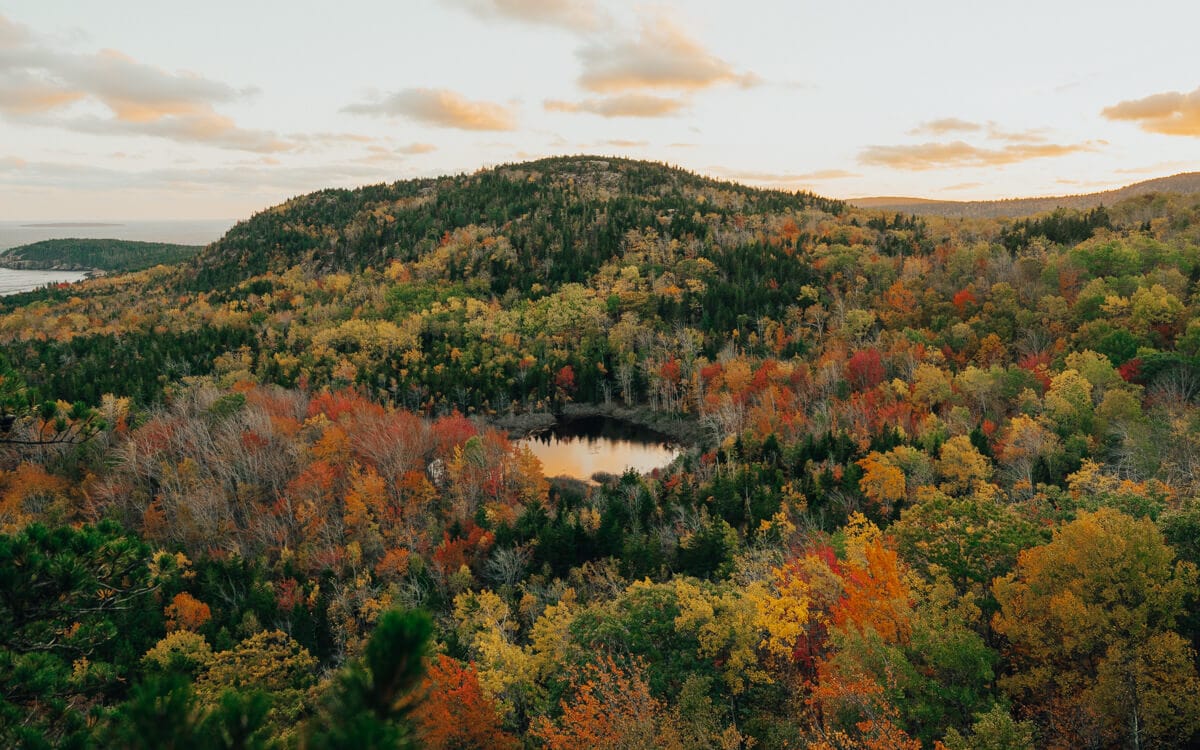
How to Get to Acadia National Park
Bangor International Airport (BGR) receives national flights for Acadia National Park.
This small airport is about an hour’s drive from Bar Harbor — which sits at the entryway to Acadia Park.
Most of the park’s incoming flights land at this quaint little airport.
So try to plan ahead in case of long waits at arrival and departure.
Alternatively, you can depart from Logan Airport in Boston for a direct flight to Hancock County Airport, 10 miles out of Acadia National Park.
If you’re on a road trip, you can start with the I-95 in Boston, Maine. From the I-95, roads lead to either Mount Desert Island or Schoodic Peninsula.
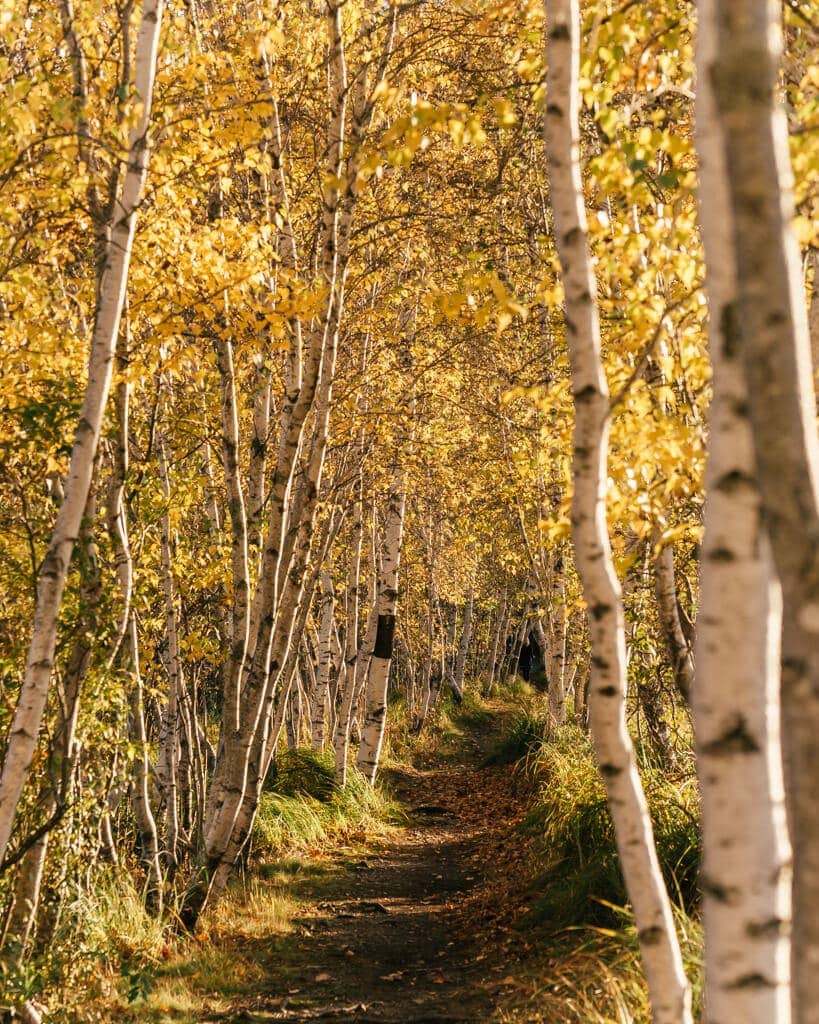
How to Get Around in Acadia National Park
The best way to get around in Acadia National Park is by rental car (or your own).
There are also seasonal ferries that run between Bar Harbor, Winter Harbor, the Schoodic Peninsula, and Mount Desert Island from May to late early October.
The ferries offer an affordable and scenic way to see the splendor of Acadia in the early fall. But, these services won’t be available if you arrive a bit later in October.
To enter Acadia National Park, you’ll have to pay an entry fee of $15 per person and $30 per vehicle. These passes are valid for seven days and can be booked online or in person.
Besides the Acadia Park entry pass, you’ll need to purchase a separate ticket for $6 if you want to enter the Cadillac Summit Road.
Be sure to book this ticket long ahead of time, as there are limited, timed-entry passes available.
Tip: If you’re a National Park fanatic, consider buying an America the Beautiful Pass. For $80, you’ll get unlimited entry into all US National Parks for a year, saving you a lot of money over time.
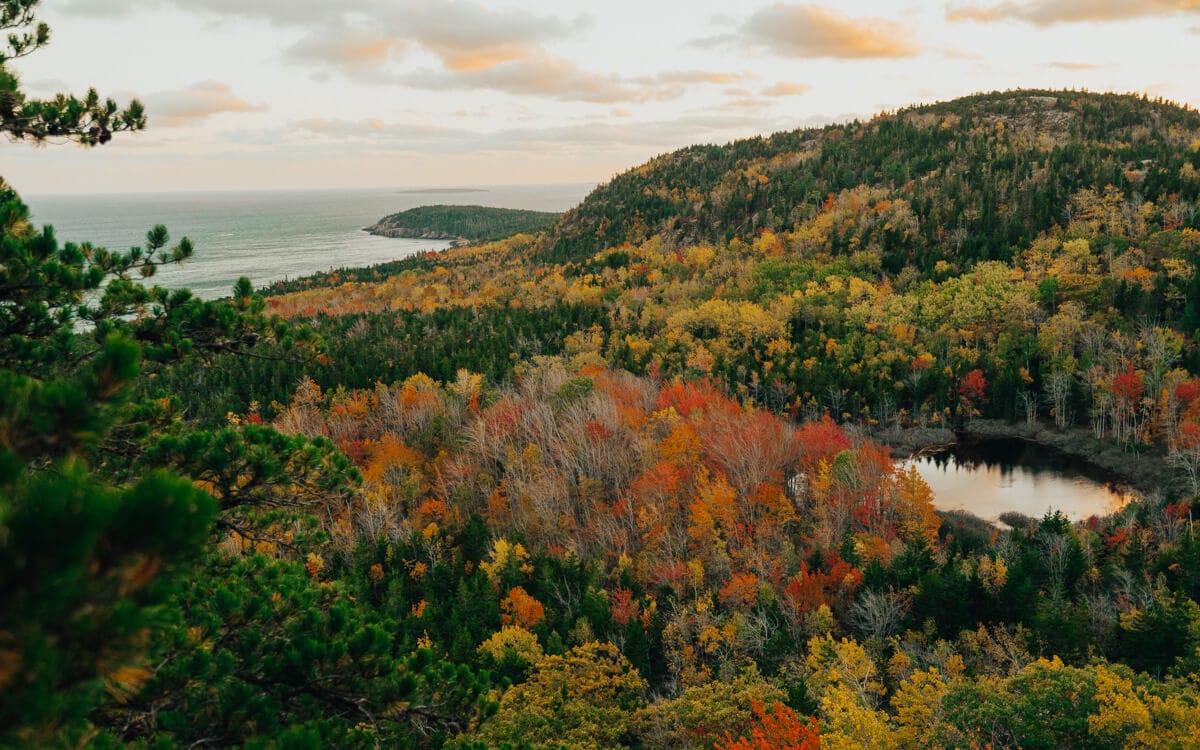
13 Things to Do in Acadia National Park in October
- Visit Jordan Pond
- Hike to the Bubble Rock Viewpoints
- Visit Sand Beach
- Hike the Beehive Trail
- Drive to the Top of Cadillac Mountain
- Stop by Thunder Hole
- Walk On The Ocean Path
- Drive Along Park Loop Road
- Take In The Views From Otter Cliff
- Bike along the Carriage Roads
- Go Camping
- See the Bass Harbor Head Lighthouse
- Explore Bar Harbor
With its granite rock formations, historic roads, and breathtaking coastline, Acadia National Park has plenty of activities on offer.
We’ll talk about each of these in the next section!
Below is a quick glance at a map I made for you.
Click here for a live version of the map!
Now let’s talk about each of these 13 things to do.
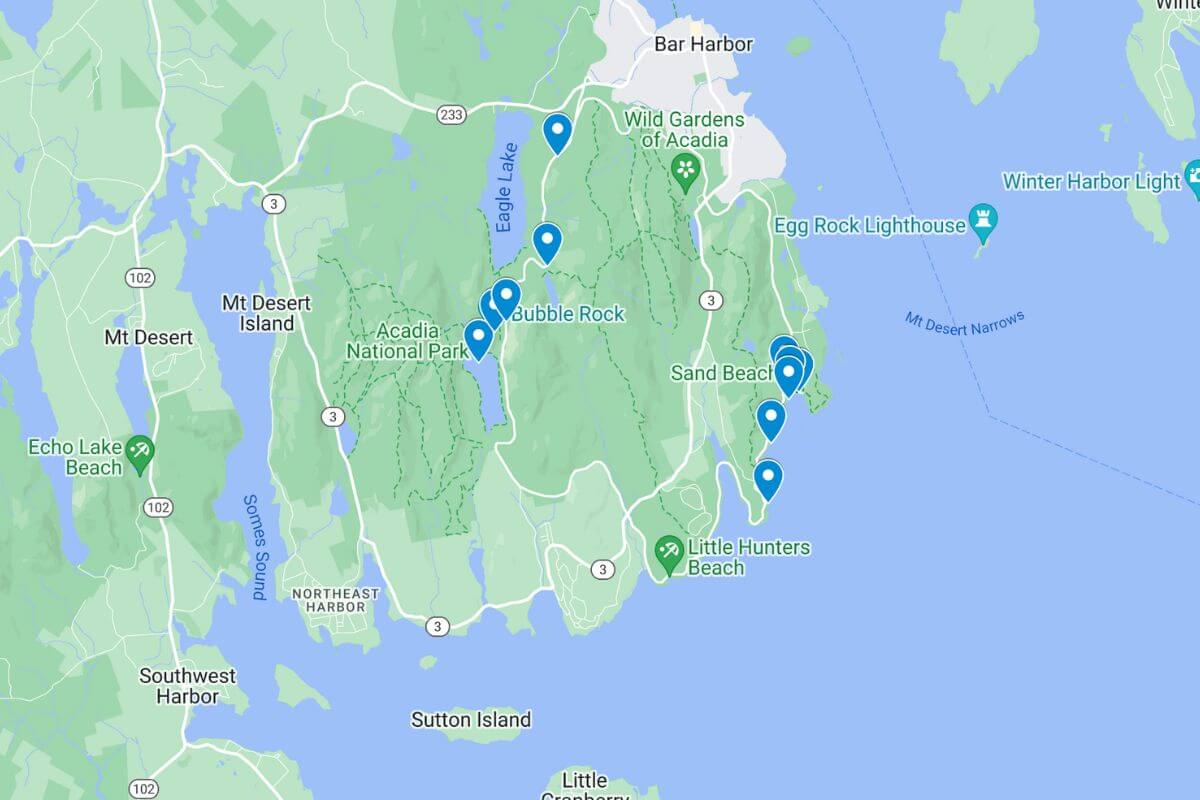
#1 Visit Jordan Pond
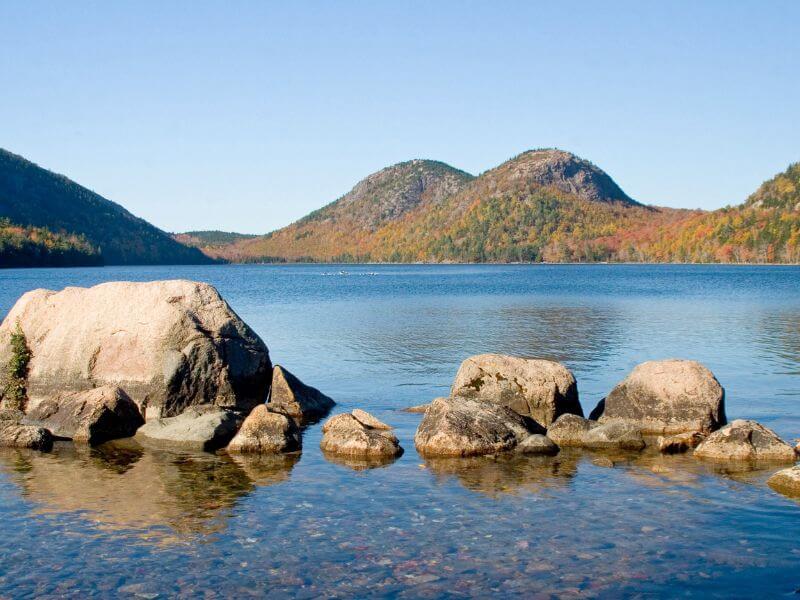
This beautiful pond is said to have formed during the last glacial period by the Wisconsin Ice Sheet. It covers a whopping 187 acres and is surrounded by trees and hills, which look especially dreamy during fall.
The quiet pond is excellent for photographing at sunset, especially when the water is still and mirrors the sky and surroundings.
It’s also a great place for a family-friendly hike, as the 3.6 miles of shoreline is relatively flat and easy to walk along.
You can make this a bit more challenging by extending your trek to the South or North Bubble viewpoints.
You can also take your paddle boat out on the water if you’re feeling extra adventurous.
But note that swimming and pets are not allowed in this pond.
Once you’ve worked up an appetite, enjoy a classic treat of tea and popovers at the Jordan Pond House, which they’ve been serving since 1893.
Read Next: Perfect Day Trip to Portland, Maine
#2 Hike to the Bubble Rock Viewpoints
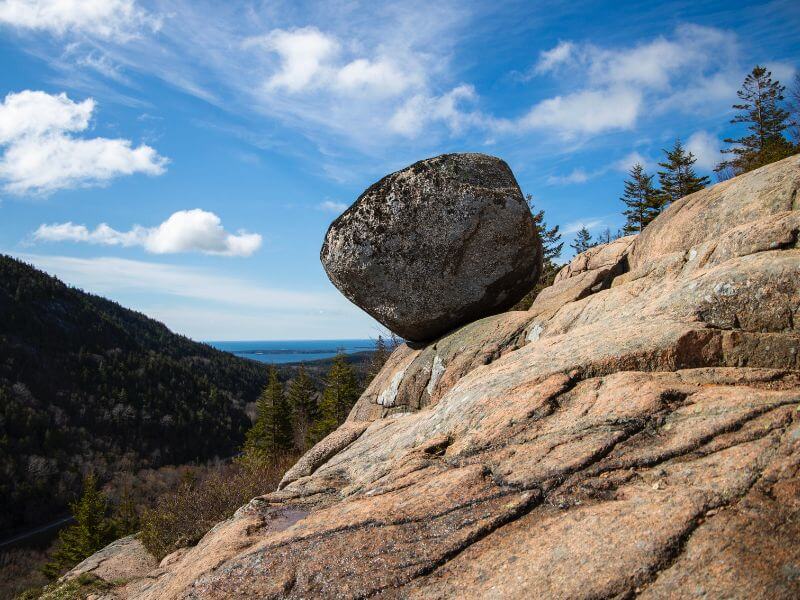
The Bubble Rock is one of Acadia National Park’s iconic viewpoints — and perhaps even one of the most iconic boulders in Maine.
This large round boulder sits on the eastern edge of the South Bubble summit, looking somewhat unsteady.
Interestingly, this boulder is said to have been moved almost 40 miles south of Lucerne by glaciers.
You can reach this viewpoint via the Bubbles Trail or Bubble Divide Trail.
The 1.6-mile Bubbles trail kicks off at the Park Loop Road parking lot.
You can also follow signs along the Jordan Pond trail that’ll lead you to these paths.
Both the North and South Bubble provide spectacular views of Jordan Pond.
But you’ll find the most unobstructed views at South Bubble, as the higher-up North Bubble view is slightly obstructed by towering tree tops.
Tip: You’ll want to 16-35mm f/4 lens and your other camera gear to capture the beautiful vistas at the top!
#3 Visit Sand Beach
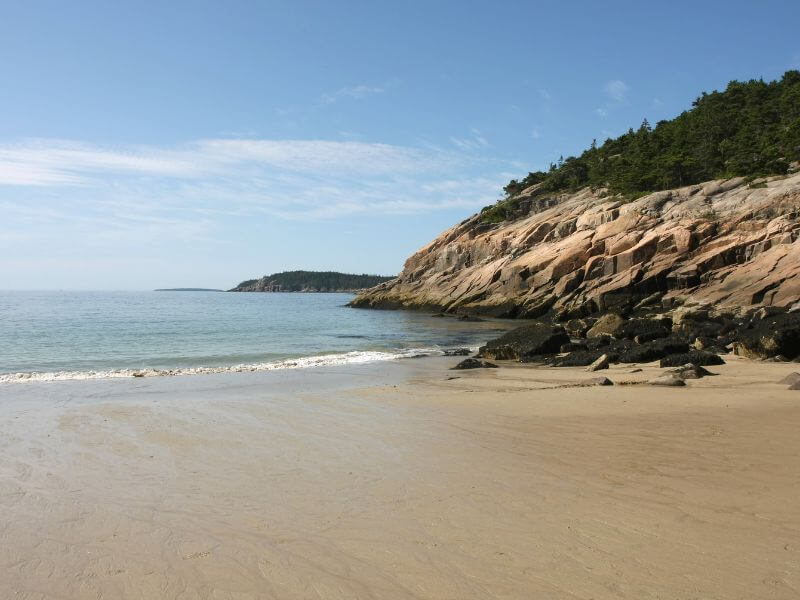
This tropical-looking, sandy beach with its turquoise waters is a great place to walk along and take some photos.
You can also bring your dog onto the beach if you visit between September and June.
If you’re brave enough to swim in the fall, you can go for a dip in the ocean.
The nearby parking lot has water fill-up stations and restrooms for your convenience.
Tip: Do note that the parking lot can fill up quickly, as hikers heading up the Beehive Trail tend to park here.
#4 Hike the Beehive Trail (My Fave Acadia Fall Hike)
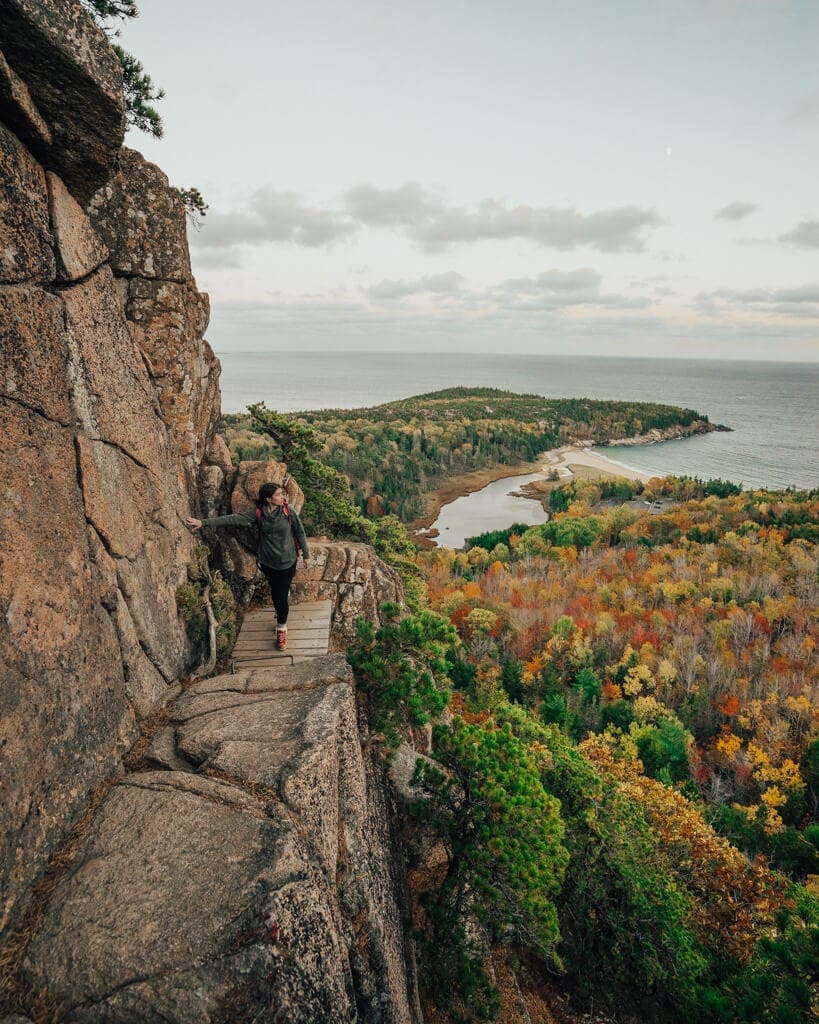
While you’re at Sand Beach, you may as well consider hiking up the Beehive Trail.
Not only for the unbeatable views of Sand Beach but also for the pure adrenaline rush it offers.
This advanced trail involves making your way over boulders, walking on narrow ridges, and climbing metal ladders.
The 1.4-mile round trip trail may be challenging, but you’ll be rewarded with panoramic vistas.
You’ll spot Sand Beach, Thunder Hole, Newport Cove, and the Gulf of Maine beyond a blanket of golden fall foliage.
#5 Drive to the Top of Cadillac Mountain
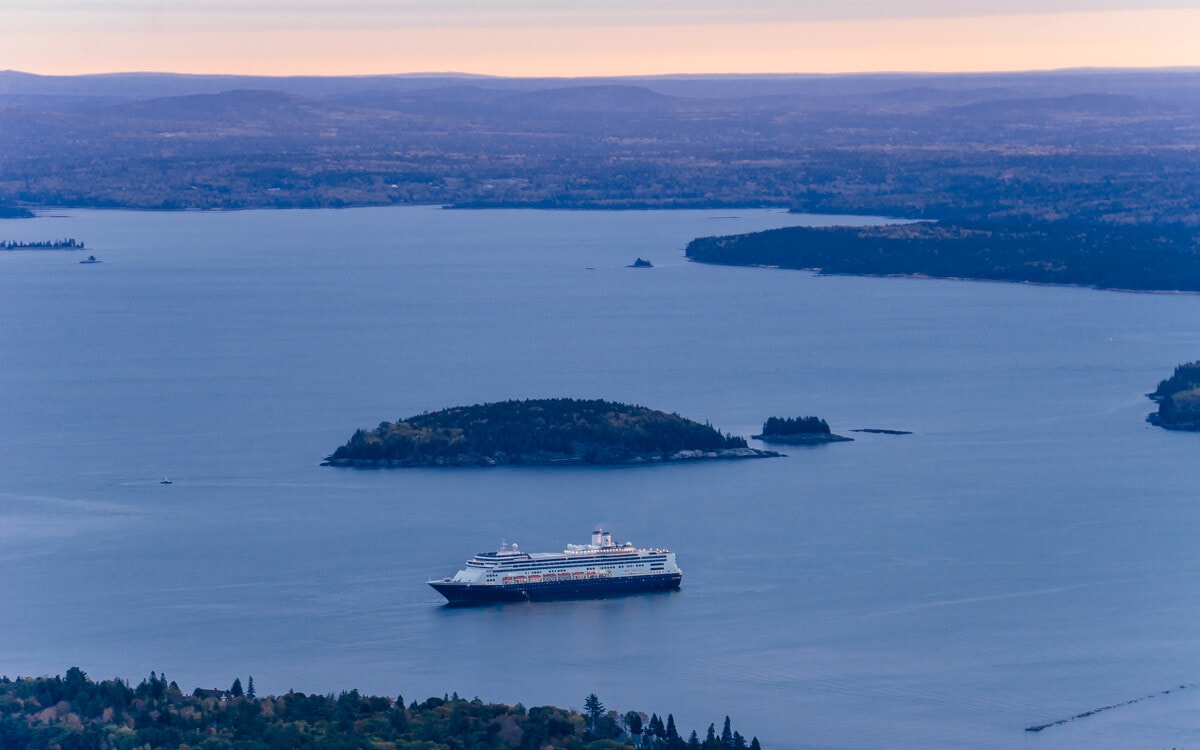
The drive up Cadillac Mountain is one of the top activities in Acadia National Park.
Standing at 1530 feet, this mountain is the highest point on the East Coast.
It is one of the first places to witness the sunrise in the United States between October and March.
For this reason, sunrise tickets sell out fast, so be sure to book ahead.
The 3.5-mile road leads all the way to the top, where you’ll find a parking lot, gift shop, restrooms, and jaw-dropping 360-degree views.
Be sure to check the weather ahead of time, as you won’t get to see much on misty or cloudy days.
Tickets are released 90 days or two days in advance.
If you’re spending a few days near Acadia, getting a ticket two days in advance with better knowledge of the weather forecast may be safer.
Tip: If you’d like all the planning and driving handled for you, why not book a 3-hour private tour leading to some of Acadia’s top attractions?
#6 Stop by Thunder Hole
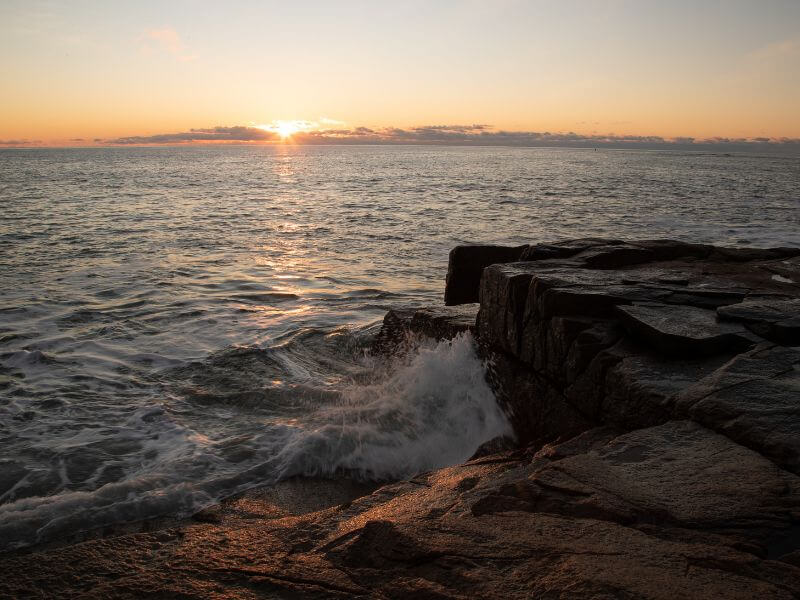
This interesting creation of nature sits along the rocky shoreline of Acadia National Park on the east end of Mount Desert Island.
Thunder Hole is a rocky inlet with a small cavern filled with water and air.
In the hours before high tide, this cavern produces a thundering sound as incoming waves are expelled with great force — up to 40 feet!
If you don’t arrive in time to hear and see this interesting occurrence, you can simply enjoy the views.
You’ll spot Otter Cliff to your right, Sand Beach and Great Head to your left, and the Schoodic Peninsula in the distance.
Note: Keep in mind that this area can be dangerous. Avoid standing too close to the mouth of the inlet, and be weary of wet, slippery rocks.
#7 Walk on the Ocean Path
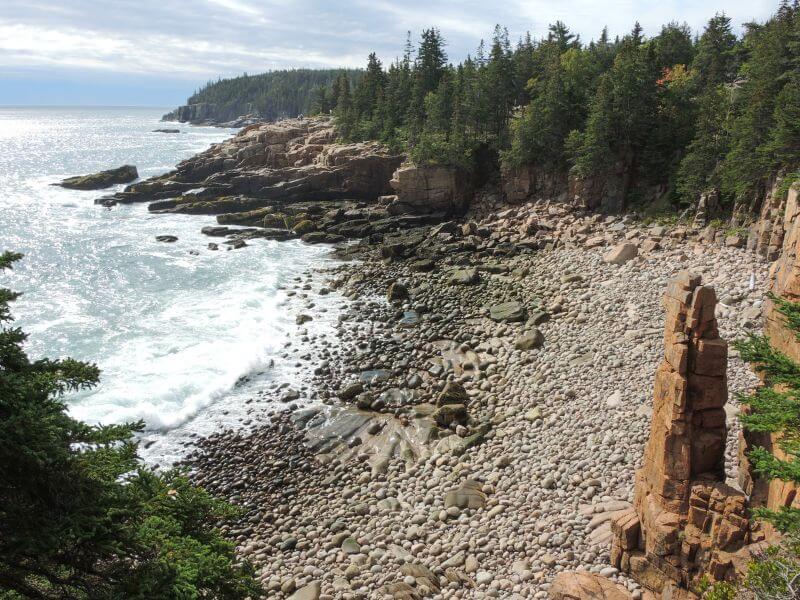
The 3-mile-long Ocean Path offers excellent views of the eastern seaboard.
The walking trail kicks off at the Sand Beach parking lot, leading past Thunder Hole, and ends at Otter Cliff.
It’s a lovely, scenic walk with minimal elevation gain, making it great for people of all fitness levels.
#8 Drive Along Park Loop Road
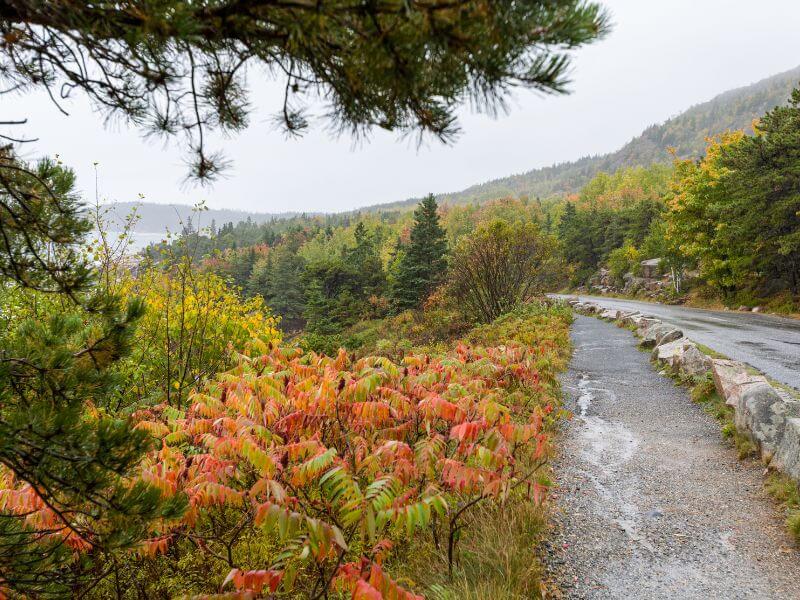
The 27-mile-long paved highway of Park Loop Road leads past some of the top attractions in Acadia National Park.
If you’re feeling a bit too chilly for a hike, or you’re simply short on time, this scenic drive is the perfect solution.
This loop starts at the Hulls Cove Visitors Center, leading past rows of trees in fall colors and all the top attractions.
These include Cadillac Mountain, Sand Beach, Otter Cliff, Thunder Hole, and Jordan Pond.
Tip: Try out this self-guided driving audio tour to learn more about this beautiful park and Bar Harbor along the way.
#9 Take in the Views From Otter Cliff
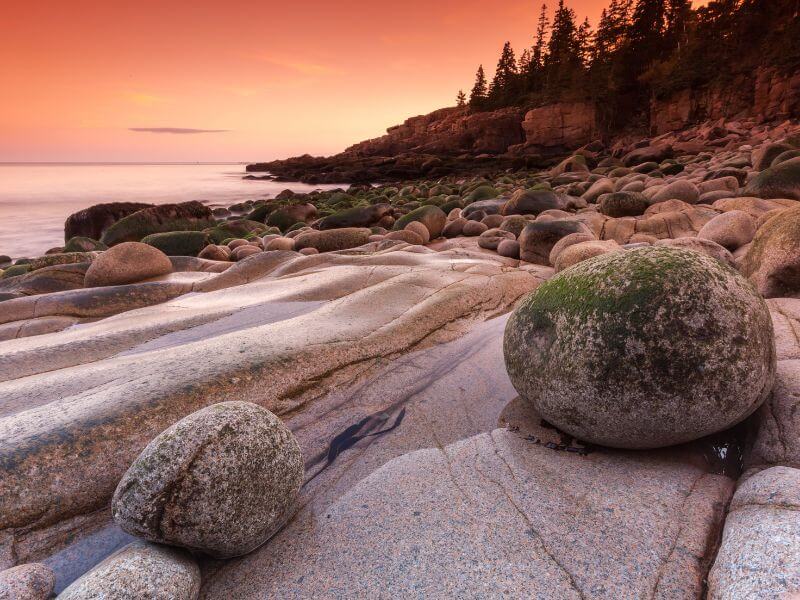
For postcard-worthy views, head to the 110-foot high Otter Cliff — one of the highest Atlantic headlands north of Rio de Janeiro.
The jagged, squared edges of the coastal cliff are contrasted by rounder rocks in the forefront, crashing waves, and tall evergreens.
This spot on the coast is not as busy as other attractions on Mount Desert island, making it a great alternative place to witness the sunrise.
If you’d like to make your visit more adventurous, this cliff is also a popular sea-cliff climbing spot.
#10 Bike Along the Carriage Roads (Popular Acadia National Park Fall Activity)
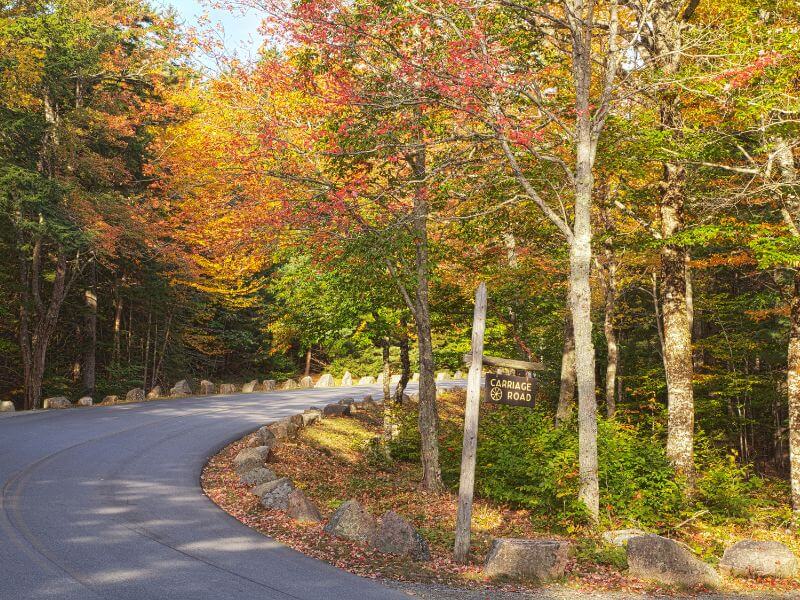
If you’re eager to enjoy the crisp fall air, why not explore the park by bike?
The Carriage Roads in Acadia National Park were built by horseman John D. Rockefeller Jr. in the early 1900s, using crushed rock to pave them.
Stretching for 45 miles, these roads wind through the heart of the park, meeting at various intersections marked with wooden directional posts.
Rent an e-bike or bring your own bicycle along.
Be sure not to exceed 20 mph and always yield to pedestrians and horses.
#11 Go Camping
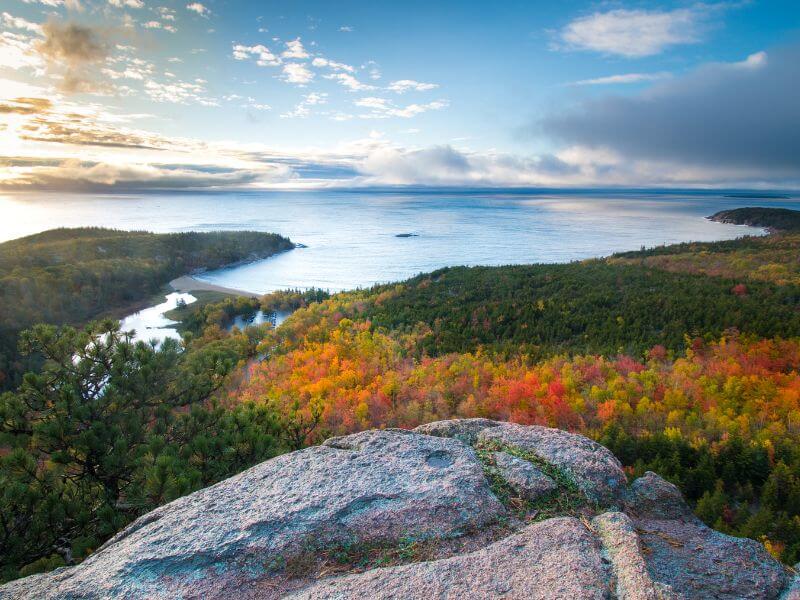
Fall is the perfect time to cozy up around a campfire and enjoy the scent of the woods. Acadia National Park offers four campsites:
- Blackwoods Campground (near Bar Harbor)
- Seawall (near Southwest Harbor)
- Duck Harbor (Isle au Haut)
- Schoodic Woods (On Schoodic Peninsula)
Nightly rates for these sites range from $20-30 per person.
Tip: Many of these campsites need to be booked 60 days in advance, with reservations opening around March, so be sure to plan ahead.
#12 See the Bass Harbor Head Lighthouse
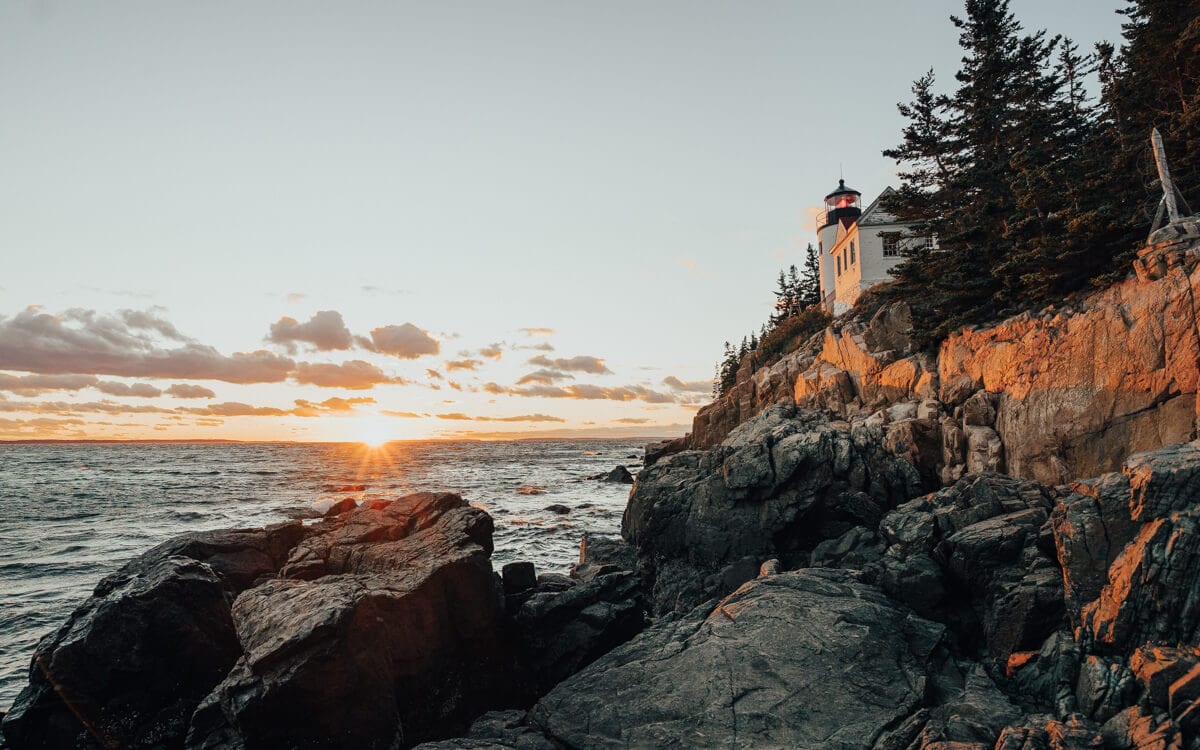
This historic lighthouse sits on jagged cliffs among verdant trees in Bass Harbor.
Standing 56 feet above the waters, this lighthouse marks the entrance to Bass Harbor and was built in 1858.
It’s a great spot to photograph and offers beautiful coastal views.
Walk around the lighthouse to learn more about the light station and see the light and 4,000-pound fog bell up close.
You can also follow a stairway down to the cliffs and settle down on one of the rocks for a supreme sunset view.
#13 Explore Bar Harbor
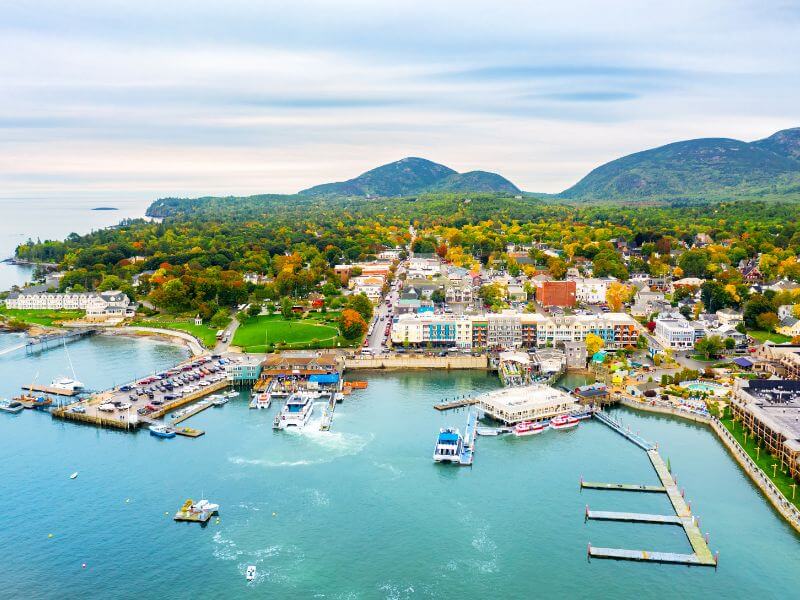
While this charming little downtown area is not in Acadia National Park, it’s near enough to the park’s entrance to be included in this list.
This quaint town is filled with eateries, bars, souvenir stores, and hotels.
It also boasts some interesting architecture, with quirky and colorful facades.
You can still enjoy the fall foliage by strolling through the streets or relaxing at Agamont or Village Green Park.
Of course, with great exploring comes great hunger, and this little town certainly won’t disappoint.
For a quick breakfast, head to Coffee Hound Coffee Co. or 2 Cats Bar Harbor.
You also can’t go wrong with anything lobster from Side Street Cafe — their Lobster mac & cheese is a crowd favorite.
End your day with a sundowner at Barnacle or a dinner at Geddy’s.
Where to Stay in Acadia in Fall
While there are no hotels in Acadia, there are some excellent accommodation options a few miles from the park’s entrance. Have a look at these options below.
Best Western Acadia Park Inn — Mid-range

Less than 2 miles from Acadia National Park, the Best Western Acadia Park Inn offers spacious rooms, a lush garden with a play area and fire pit, and a complimentary buffet breakfast. You’re even allowed to bring your furry friend along — they’ll certainly love the ample running space in the yard.
Bar Harbor Cottage — Mid-range

Situated 3 minutes from the entrance to Acadia National Park, this enchanting cottage sleeps up to four people in two bedrooms. This red home features cozy amenities like a fireplace, rustic kitchen, and a backyard deck you can enjoy while you admire the nature surrounding you.
The Primrose — Mid-range

An elegant bed and breakfast where you’ll be just a mile from Acadia. The Victorian-style rooms will leave you in awe, but so will the fluffy pumpkin pancakes. Spend your day exploring the park then come back to your room to cozy up by the fireplace.
Final Thoughts on Acadia in the Fall
Hopefully, this list has left you giddy with excitement to see the Acadia National Park Fall spectacle. With coastal vistas, rocky cliffs, ponds, and plenty of hiking trails on offer, you won’t have a moment of boredom in this park.
While Acadia National Park is a must-see destination in the fall, there are many other places in New England that turn equally breathtaking during fall. You’ll find plenty to do in Stowe during the fall. Or you can head further north to see Banff’s fall foliage in full swing.
+ show Comments
- Hide Comments
add a comment